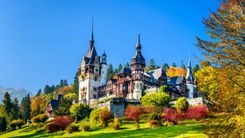The early stages of our route followed the trails of Europe’s last nomadic shepherds. Every summer a swarm of cattle stamps these paths flat, but today the traffic was made up of yellow-bellied toads who panicked from puddle to puddle. Dan delighted in scooping one up, showing me its elaborate colouring that would be far better suited in a Madagascan swamp. We soon discovered why they were in such a hurry.
“How long ago was it here?” I whispered as we bent over a series of bear paw prints. Recently, he told me, a few hours perhaps, and almost instantaneously my perception of the forest changed. Gaps between tree trunks became bears on their hind legs. Birds were no longer flying, they were escaping. Twig cracks and ground thumps closed in on us. The bear tracking had begun.
Our next clue was something that only Dan would have spotted.
“Do you see this yellow stuff here?” he was on his tiptoes pointing to waxy build-up on the side of a tree trunk. “This is sap. And do you see what is stuck to it?”
My eyes snapped into focus and a thin layer of hairs sprang from the tree. Sap is like catnip for bears, and once I started looking out for it almost every trunk had a membrane of hairs, as if the trees were passing through the final stages of evolution before becoming creatures of the forest themselves.








